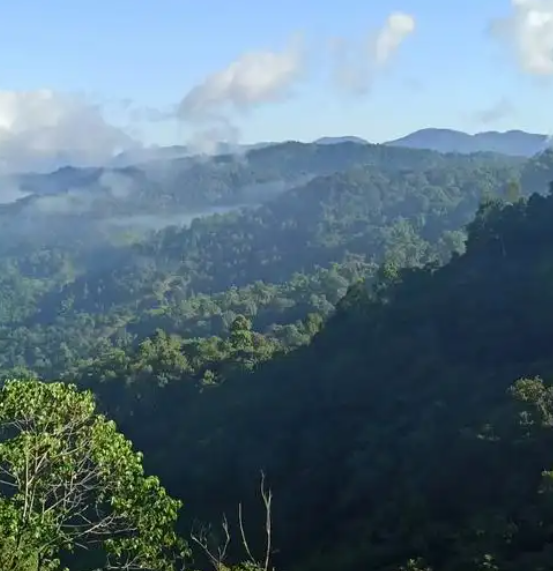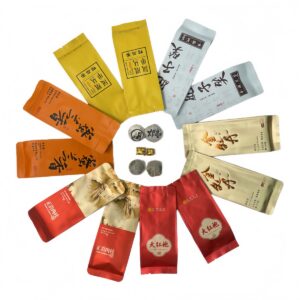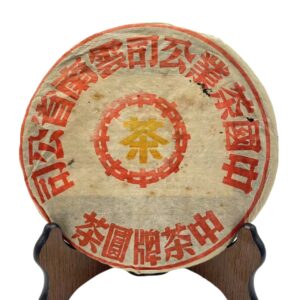To understand what the best Pu Erh tea is, we must first explore its origins. Pu Erh tea traces its roots back to the Eastern Han Dynasty, when the Pu people of Yunnan harvested wild tea. By the Tang Dynasty, texts like the Man Shu already documented the flourishing tea production in Yinxing City. During the Ming and Qing dynasties, Pu Erh tea was exported via the ancient Tea Horse Road to Tibet and Southeast Asia. Under Emperor Yongzheng of the Qing Dynasty, it was even designated as imperial tribute tea, and Emperor Qianlong bestowed it the plaque “Rui Gong Tian Chao” (Auspicious Tribute to the Imperial Court). This trade route, centered on the exchange of horses and tea, not only boosted economic ties but also served as a cultural bridge connecting Han, Tibetan, and Dai ethnic traditions.
In 1973, the modern wo dui (wet-piling) fermentation technique was developed, enabling large-scale production of ripe Pu Erh (shu cha). In the 21st century, the boom in ancient tree Pu Erh has elevated it to a globally sought-after collectible and investment item.
I. The Soul of the Best Pu Erh Tea: The Science Behind Raw and Ripe
To be considered the best Pu Erh tea, the soul lies in its fermentation process:
- Raw Pu Erh (Sheng Cha): Naturally aged over time, retaining the original flavor of the tea leaves. Ancient tree raw tea contains up to 40% more tannins than plantation tea. After aging for 10+ years, it develops woody notes and honey-like aromas—exemplified by ancient tree teas from Lao Ban Zhang.
- Ripe Pu Erh (Shu Cha): Undergoes a 45–60 day temperature- and humidity-controlled wo dui fermentation. This process boosts theaflavin content by 50%, yielding a mellow, date-like aroma and silky mouthfeel. The Menghai-style ripe Pu Erh is a classic representation.
The kill-green process is critical to quality—iron woks must maintain temperatures around 200°C, ensuring leaf surfaces reach 60–80°C. This halts enzymatic activity while preserving enough active compounds for future aging.

II. Key Factors That Define the Best Pu Erh Tea
The region of origin is key to identifying the best Pu Erh tea. There are three major core production areas in Yunnan, each with its own microclimate, altitude, and tea tree variety—leading to distinct flavor profiles:
1. Xishuangbanna Tea Region
- Location: Southernmost Yunnan, covering Menghai and Mengla counties. One of the oldest Pu Erh-producing regions.
- Notable Subregions:
- Menghai Area (Bulang Mountain, Nannuo Mountain): Strong, bold teas with high bitterness and powerful aroma. Representative teas include Lao Ban Zhang and Lao Man E.
- Yiwu Area (Mahei, Gua Feng Zhai): Known for “fragrant and soft” profiles—smooth texture, lingering aftertaste. Yiwu Pu Erh is highly prized.
- Overall Profile: Bold, astringent, with rapid post-fermentation development and strong sweetness return.

2. Lincang Tea Region
- Location: South-central Yunnan along the Lancang River, known as “China’s tea warehouse” for its abundance of ancient tea trees.
- Key Mountains:
- Bingdao: Famous for its rock candy sweetness and low bitterness.
- Xigui: Intense tea energy with aromas of herbs and ginseng—dubbed the “Ban Zhang of Lincang.”
- Daxue Mountain, Xiaohusai: Unique aromas, light bitterness, and minimal astringency.
- Profile: Aromatic and easy to drink—great for beginners.
3. Pu’er Tea Region (formerly Simao)
- Location: South-central Yunnan, historically a key stop on the Tea Horse Road.
- Representative Mountains:
- Jingmai Mountain: Distinct orchid fragrance, light bitterness, quick return sweetness.
- Kunlu Mountain, Bangwei: Gentle taste with honey-like aroma.
- Profile: Elegant and mild, with strong aging potential and cultural significance.
Summary:
Each region has its own character—Lincang teas are sweet, Banna teas are bitter and bold, and Pu’er teas are fragrant and gentle. Your choice depends on personal preference:
Love bold, punchy tea? Go for Lao Ban Zhang.
Prefer smooth sweetness? Try Bingdao.
Obsessed with floral notes? Jingmai is your pick.
We select Pu’er from high-quality production areas for sale. Please click the following link to purchase.
III. The Value of the Best Pu Erh Tea: A Trio of Health, Heritage, and Investment
- Health Benefits: One daily cup of ripe Pu Erh can reduce LDL cholesterol by up to 26%. Its tea polyphenols are 40% more effective at neutralizing free radicals than green tea. L-theanine in raw Pu Erh enhances focus by 35% and helps soothe liver heat.
- Cultural Symbolism: Pu Erh tea represents the spirit of the Tea Horse Road. In 2025, it received EU Geographical Indication certification—boosting its global reputation.
- Investment Potential: Sales of Pu Erh tea on Amazon are growing 120% year-over-year. Whole Foods lists Pu Erh as a “superfood of 2025.” One 2000 vintage Dayi 7542 tea cake stored in optimal dry conditions was auctioned for over $70,000.
IV. The Art of Brewing Pu Erh: Unlocking Ultimate Flavor
- Traditional Gongfu Brewing:
- Raw Pu Erh: Brew with 100°C water in a Yixing clay teapot. Yields up to 8 infusions with lingering aroma.
- Ripe Pu Erh: Brew with boiling water in a ceramic pot to unlock depth and smoothness.
- Cold Brew Innovation:
- Combine 5g ripe Pu Erh with dried orange peel and cold water. Refrigerate for 8 hours. Tannins are reduced by 40%, while sweetness doubles.
- Functional Fusion:
- Blending Pu Erh powder with maca and BCAAs creates a new energy drink ideal for workout recovery or office focus.
V. Conclusion: So, What Is the Best Pu Erh Tea?
There’s no absolute answer. Some Pu Erh teas sell for $70,000 a cake—if someone can afford and truly enjoys it, that might be their best Pu Erh tea.
For everyday drinkers, the best Pu Erh tea is the one that suits your palate, delivers health benefits, and fits your budget. If it makes you feel good, warms your soul, and becomes part of your daily ritual—then that, right there, is your best Pu Erh tea.
What do you think?




